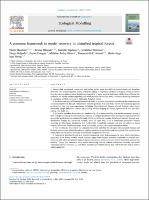| dc.description.abstract | Despite their exceptional biodiversity and carbon stocks, more than 80% of tropical forests are disturbed. However, a lot of interrogations remain around the ability of vegetation attributes in tropical forests to recover from the various anthropogenic disturbances coexisting in many tropical landscapes. While these different disturbances are usually studied separately, this work provides, for the first time, a common modelling framework of vegetation attribute recovery in differently disturbed forests. We develop an original Bayesian hierarchical model of recovery trajectories, considering disturbed forests in a common framework, through a disturbance intensity gradient. As a case study, we test our modelling approach on data from two long-term experiments, Tirimbina (Costa Rica) and Paracou (French Guiana), where forest permanent sample plots have been set up following selective logging (63.25 ha), agriculture (4 ha), and clearcutting+fire (6.25 ha). We build a modelling framework that stands out by: (i) its interpretability, with model parameters having a clear ecological meaning; (ii) its robustness, allowing to compare parameter values amongst ecological systems to ensure that predictions are ecologically sound; (iii) its versatility to consider disturbance intensity through postdisturbance changes in a structural variable, either as input data, or as a transformed parameter without requiring pre-disturbance monitoring; (iv) its flexibility to explicitly consider, and test, the effects on forest recovery of various disturbance types, along an intensity gradient, in a single integrative model. First conclusions drawn from our common framework underline the strongest above-ground biomass and diversity recovery rate offered by selective logging, compared to agriculture and clearcutting+fire, as well as the strong effect of disturbance intensity on taxonomic composition recovery. Considering disturbed forests in a common framework might help managers to know which disturbance types need to be firmly avoided, which intensity range makes human activities sustainable in forested environments, and where inexpensive natural regeneration should be favoured over active restoration, such as tree planting. Testing this framework with various monitoring tools to estimate disturbance intensity and model vegetation attribute recovery, i.e., with forest monitoring or remote sensing data, will be the next step to make it widely applicable. | es_ES |


